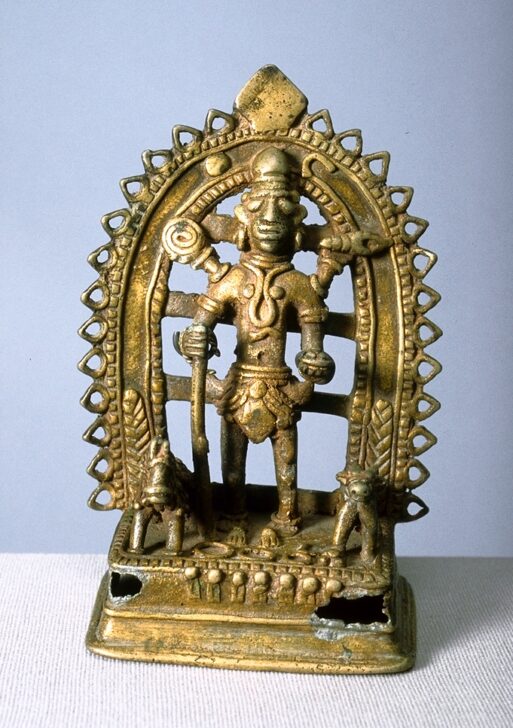Four-armed Vishnu
Indian

Description
March 28, 2009
This figure of Vishnu as Surya-Narayana was formed through a bronze-making technique that produces thick, linear details. His bulky jewelry, ovoid mouth, and spiky halo were composed first as a model, around which a clay mold was formed. After it was fired and hardened, the mold was filled with molten metal that solidified to form the final image. Different versions of this “lost wax” process could produce different results. Highly detailed objects for state-sponsored temples were made from carefully carved wax models. This folk bronze, on the other hand, was based on a simpler model composed of resin threads wrapped around a clay core. Today, such bronzes are often commissioned from itinerant craftsmen for household use. In contrast to temple sculptures, they often show a degree of flexibility with respect to the patron’s taste. This bronze, for instance, shows Vishnu with his classic attributes—the club, discus, conch, and lotus—combined with seven stylized horses, signs of the older nature god Surya.
(Label for UMMA South and Southeast Asia Gallery Opening Rotation, March 2009)
Subject Matter:
Vishnu is one of the principal gods of Hinduism, along with Shiva and the goddess, and commands a large following. He is often depicted with four arms and consistently carries four attributes: the discus, conch, club and lotus. The addition of the seven horses at the base lets us know that this is a combination of the god Vishnu and the sun god Surya. This is a common combination in iconographies that try to link many of the older nature gods with the fully developed pantheon of Hinduism.
Physical Description:
Vishnu stands with his legs apart holding his four attributes in his hands. Reading in clockwise direction from his right front hand he holds: his club, discus, conch and lotus, here a rather flat object cupped in his palm. His back two arms are extremely short. The figure is encircled with a decorated arch with a line of beads and triangular shaped openings around them. A stylized sun and moon are to either side of Vishnu’s head. He wears a variety of simple, lumpy jewelry at his feet are a horse to his right and a bull or cow to his left and between them are three rings lying flat on the base. At the front of the base are seven stylized horses, identifying this as a combination figure: Vishnu and the sun god Surya, whose chariot is pulled by seven horses.
Usage Rights:
If you are interested in using an image for a publication, please visit https://umma.umich.edu/request-image/ for more information and to fill out the online Image Rights and Reproductions Request Form.